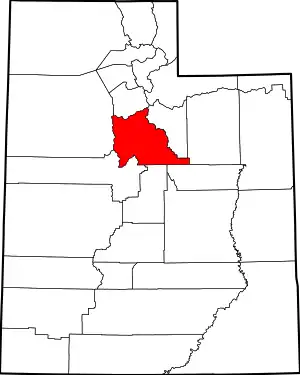Lehi, Utah
Lehi (/ˈliːhaɪ/ LEE-hy) is a city in Utah County, Utah, United States. It is named after Lehi, a prophet in the Book of Mormon. The population was 47,407 at the 2010 census,[5] up from 19,028 in 2000. A more recent 2019 estimate reports a population of 69,724.[6] The rapid growth in Lehi is due, in part, to the rapid development of the tech industry region known as Silicon Slopes. The center of population of Utah is located in Lehi.[7]
Lehi, Utah | |
|---|---|
City | |
 Lehi Tabernacle in 1913 | |
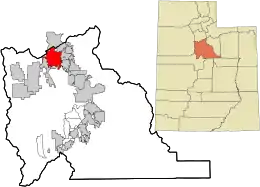 Location in Utah County and the state of Utah | |
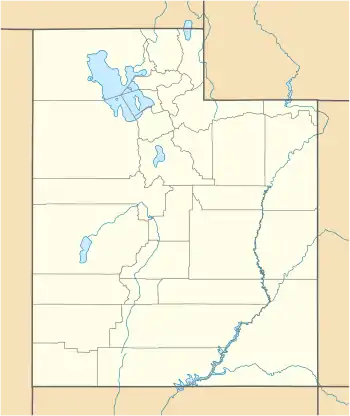 Lehi Location within Utah  Lehi Location within the United States | |
| Coordinates: 40°23′16″N 111°50′57″W | |
| Country | United States |
| State | Utah |
| County | Utah |
| Settled | 1850 |
| Incorporated | February 5, 1852 |
| Named for | Lehi |
| Government | |
| • Mayor | Mark Johnson |
| Area | |
| • Total | 28.45 sq mi (73.69 km2) |
| • Land | 28.09 sq mi (72.74 km2) |
| • Water | 0.36 sq mi (0.94 km2) |
| Elevation | 4,564 ft (1,391 m) |
| Population (2010) | |
| • Total | 47,407 |
| • Estimate (2019)[2] | 69,724 |
| • Density | 2,482.52/sq mi (958.51/km2) |
| Time zone | UTC−7 (Mountain (MST)) |
| • Summer (DST) | UTC−6 (MDT) |
| ZIP code | 84043 |
| Area code(s) | 385, 801 |
| FIPS code | 49-44320[3] |
| GNIS feature ID | 1442553[4] |
| Website | https://www.lehi-ut.gov |
Lehi is part of the Provo–Orem Metropolitan Statistical Area.
History
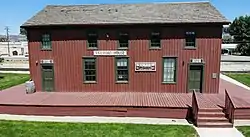
A group of Mormon pioneers settled the area now known as Lehi in the fall of 1850 at a place called Dry Creek in the northernmost part of Utah Valley. It was renamed Evansville in 1851 after David Evans, a local bishop in The Church of Jesus Christ of Latter-day Saints (LDS Church). Other historical names include Sulphur Springs and Snow's Springs.[8]
The land was organized into parcels of 40 acres (160,000 m2), and new settlers received a plot of this size until the entire tract was exhausted. There was little water to irrigate the rich soil, so it became necessary to divert a portion of American Fork Creek. Evansville consumed up to one-third of the creek's water, as authorized by the Utah Territorial Legislature.
The settlement grew so rapidly that in early 1852, Bishop David Evans petitioned the Utah Territorial Legislature to incorporate the settlement. Lehi City was incorporated by legislative act on February 5, 1852. It was the sixth city incorporated in Utah. The legislature also approved a request to call the new city Lehi after a Book of Mormon prophet of the same name.[9]
The downtown area has been designated the Lehi Main Street Historic District by the National Park Service and is on the National Register of Historic Places.
Geography
According to the United States Census Bureau, the city has a total area of 26.7 square miles (69.1 km2) of which 26.3 square miles (68.2 km2) is land and 0.35 square miles (0.9 km2), or 1.28%, is water.[10]
Transportation
I-15 runs through Lehi, with four exits (at Lehi Main St, 2100 North/1200 West, Timpanogos Highway/SR-92, American Fork Main Street/Pioneer Crossing) located in the city.[11] The Utah Transit Authority operates a bus system that reaches into the city. Work on the FrontRunner South commuter rail began in August 2008, and the Lehi station opened for service on December 12, 2012.[12] The Lehi station is located near Thanksgiving Point.
Demographics
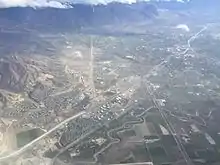
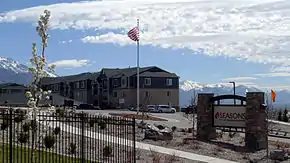
| Historical population | |||
|---|---|---|---|
| Census | Pop. | %± | |
| 1890 | 1,907 | — | |
| 1900 | 3,033 | 59.0% | |
| 1910 | 3,344 | 10.3% | |
| 1920 | 3,078 | −8.0% | |
| 1930 | 2,826 | −8.2% | |
| 1940 | 2,733 | −3.3% | |
| 1950 | 3,627 | 32.7% | |
| 1960 | 4,377 | 20.7% | |
| 1970 | 4,659 | 6.4% | |
| 1980 | 6,848 | 47.0% | |
| 1990 | 8,475 | 23.8% | |
| 2000 | 19,028 | 124.5% | |
| 2010 | 47,407 | 149.1% | |
| 2019 (est.) | 69,724 | [2] | 47.1% |
| U.S. Decennial Census[14] | |||
As of the American Community Survey (ACS) Demographic and Housing Estimates of 2016,[15] there were 56,314 people living in the city with 14,853 housing units. The estimated racial makeup of the city was 94.6% European American, 0.1% African American, 0.5% Native American, 1.2% Asian, 0.2% Pacific Islander, 1.3% from other races, and 2.1% from two or more races. Hispanic or Latino of any race were 6.5% of the population. An estimated 51.2% of the population was male with 48.8% female. The median age as of 2016 was 24.7.
According to the 2010 Census,[16] there were 12,402 households, out of which 61.0% had children under the age of 18 living with them, 78.4% were husband-wife families living together, 3.2% had a male householder with no wife present, 7.1% had a female householder with no husband present, and 11.3% were non-families. 9.0% of all households were made up of individuals (living alone) and 11.7% had someone living alone who was 65 years of age or older. The average household size was 3.81 and the average family size was 4.08.
As of 2018, the median income for a household in Lehi was $74,200, and the median income for a family was $88,278. The per capita income for the city was $25,894, including all adults and children. The unemployment rate for Lehi was 3.0%. The job growth rate was at 2.6% and was expected to grow 54.8% over the next 10 years.[17]
Climate
| Climate data for Lehi, Utah | |||||||||||||
|---|---|---|---|---|---|---|---|---|---|---|---|---|---|
| Month | Jan | Feb | Mar | Apr | May | Jun | Jul | Aug | Sep | Oct | Nov | Dec | Year |
| Average high °F (°C) | 37 (3) |
43 (6) |
52 (11) |
61 (16) |
72 (22) |
82 (28) |
90 (32) |
88 (31) |
79 (26) |
64 (18) |
48 (9) |
39 (4) |
63 (17) |
| Average low °F (°C) | 16 (−9) |
19 (−7) |
28 (−2) |
34 (1) |
41 (5) |
48 (9) |
55 (13) |
54 (12) |
45 (7) |
34 (1) |
25 (−4) |
18 (−8) |
35 (2) |
| Average precipitation inches (mm) | 0.98 (24.9) |
1.00 (25.4) |
1.12 (28.4) |
1.3 (33) |
1.40 (35.6) |
0.66 (16.8) |
0.7 (17) |
0.98 (24.9) |
1.15 (29.2) |
1.33 (33.8) |
1.13 (28.7) |
0.69 (17.5) |
12.44 (315.2) |
| Source: weather.com[18] | |||||||||||||
Attractions
Lehi Roller Mills
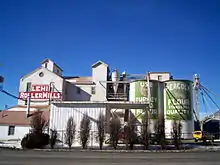
| Location | 700 E. Main St., Lehi, Utah |
|---|---|
| Coordinates | 40°23′18.4″N 111°50′11″W |
| Area | 2.9 acres (1.2 ha) |
| Built | 1905 |
| Built by | Wolf Company |
| NRHP reference No. | 94000535[19] |
| Added to NRHP | May 26, 1994 |
Lehi Roller Mills was founded in 1906 by a co-op of farmers. George G. Robinson purchased the mill in 1910, and it has since remained in the Robinson family, currently run by George's grandson, R. Sherman Robinson.
At the turn of the 21st century, Lehi Roller Mills was among thousands of such family-owned mills operating in the United States. Fewer than fifty remain today. High demand keeps the mill grinding around the clock, six days a week, and the mill produces some 100,000 pounds of flour each day. However, in 2012, the Mills filed for bankruptcy with the intention of continuing to operate during the proceedings.[20]
Lehi Roller Mills was featured in the 1984 film Footloose as Ren McCormack's (Kevin Bacon) workplace and as the site of the dance.
The iconic turkey and peacock flour paintings of Lehi Roller Mills were painted on the silos about 1930 by Stan Russon of Lehi, Utah. He used a rope and pulley system to manually raise and lower himself to be able to paint.
At the time the film was made, Lehi Roller Mills was surrounded by nothing but vacant fields. In one scene, the Reverend Shaw Moore (John Lithgow) and his wife Vi Moore (Dianne Wiest) keep a wary eye on the proceedings while standing in a field some distance away. The area is now home to a variety of fast food restaurants and a shopping center.[21]
The Lehi Roller Mills were listed on the U.S. National Register of Historic Places in 1994.[19][22]
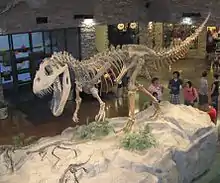
Thanksgiving Point
Thanksgiving Point is a nonprofit museum complex and estate garden founded in 1995. It consists of six main attractions: the Ashton Gardens, Thanksgiving Point Golf Course, the Museum of Ancient Life, the Museum of Natural Curiosity, Farm Country, and the Butterfly Biosphere.[23] Approximately 1.45 million people visit Thanksgiving Point each year. It is also a location for Megaplex Theaters and has several restaurants and gift shops. It is the site for the region's only Tulip Festival, an annual Scottish Festival, annual Cornbelly's Halloween attraction,[24] and Highland Games.
The complex is a 501(c)(3) organization with operations funded by private donations, venue and event admissions, and profits from shops and restaurants.[25]
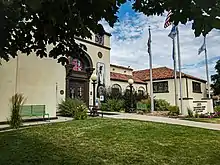
Hutchings Museum
The Hutchings Museum is a museum located near the center of Lehi. It was first established in 1955 in what is now the Lehi arts building and later moved to 55 N Center St, Lehi, UT. The collection was donated to Lehi city from John and Eunice Hutchings, who were amateur collectors and naturalists.
The Hutchings Museum's exhibits include a large range of displays and artifacts from Native American Culture, Rocks and Minerals, Veteran's Memorial, Lehi History, and much more.
Some of the Museum's most notable artifacts are Butch Cassidy's Gun, their large collection of rocks and minerals, and Native American pottery. [26]
Economy
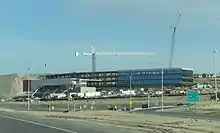
Lehi has been transitioning from an agricultural economy to a technological economy. This first started with the lengthy construction of a DRAM microchip plant by Micron Technology, which eventually evolved into a NAND flash memory business called IM Flash Technologies that was founded by both Micron and the Intel Corporation with headquarters in Lehi. Currently, 1 out of every 14 flash memory chips in the world is produced in Lehi.[27]
Adobe Systems based one of its U.S. buildings in Lehi, which is home to about 900 employees. According to the Adobe website, "The team in Utah is focused on engineering, product development, sales, marketing, and operations for the industry-leading Adobe Marketing Cloud."

IASIS Healthcare built Lehi's first hospital, which opened in June 2015. The company broke ground for the medical center in February 2014. The 23-acre campus houses a 40-bed, full-service facility with an emergency department, intensive care unit, medical imaging, cardiac lab, surgical suites, and labor and delivery.[28]
Ancestry.com moved its headquarters from Provo to Lehi in May 2016. The headquarters building is located in The Corporate Center at Traverse Mountain.
Microsoft has an engineering department specializing in the next version of its MDOP (Microsoft Desktop Optimization Pack), code-named "Park City."[29] Initially employing 100, Microsoft has built a second building to house its staff.[30] Microsoft Southwest District is located at 3400 N. Ashton Blvd., Suite 300 Lehi, Utah 84043.[31]
Other Thanksgiving Park tenants are Infusionsoft, Workfront, Vivint Solar, Agel Enterprises, DigiCert, Jolt and ProPay Inc.[32]
Multi-level marketing companies XanGo, Young Living, Younique, Nature's Sunshine Products also have offices in Lehi.
Education
Lehi public schools are part of the Alpine School District with Sam Jarman as its current superintendent.[33] Alpine School District has two high schools (Lehi High School and Skyridge High School), two junior high or middle schools, and ten elementary schools in the city.[34]
Mountainland Technical College (MTECH) is a public technical training institution located in Lehi. MTECH serves high school and adult students at the Lehi location, offering programs of study in automotive, culinary arts, healthcare, information technology and a growing number of other industry and technical programs. MTECH offers community education programs such as training in basic computer skills and specific software programs and partners with many area employers in providing customized training for their employees through the Custom Fit program.[35]
Challenger School is located in Lehi, in the Traverse Mountain area.[36]
Notable people
- Garett Bolles, lineman for NFL's Denver Broncos
- Tony Finau, professional golfer playing on the PGA Tour
- Wilford Brimley, actor
- The Brown Family, subject of the TLC Show Sister Wives (former residents)
- Paul Cummings, Olympic runner, half-marathon (former) world record holder
- Porter Rockwell, bodyguard to Joseph Smith and Brigham Young
- Eldred G. Smith, Patriarch to the Church for the LDS Church
See also
- List of cities and towns in Utah
- Wines Park
References
- "2019 U.S. Gazetteer Files". United States Census Bureau. Retrieved August 7, 2020.
- "Population and Housing Unit Estimates". United States Census Bureau. May 24, 2020. Retrieved May 27, 2020.
- "U.S. Census website". United States Census Bureau. Retrieved 2008-01-31.
- "US Board on Geographic Names". United States Geological Survey. 2007-10-25. Retrieved 2008-01-31.
- "Profile of General Population and Housing Characteristics: 2010 Demographic Profile Data (DP-1): Lehi city, Utah". United States Census Bureau. Retrieved March 7, 2012.
- "Population in the U.S. - Google Public Data Explorer". www.google.com. Retrieved 2019-08-07.
- "Centers of Population by State: 2010". census.gov. United States Census Bureau. Archived from the original on 3 January 2014. Retrieved 10 October 2014.
- Archived June 15, 2011, at the Wayback Machine
- Gannett, Henry (1905). The Origin of Certain Place Names in the United States. U.S. Government Printing Office. p. 184.
- "Geographic Identifiers: 2010 Demographic Profile Data (G001): Lehi city, Utah". United States Census Bureau. Retrieved March 7, 2012.
- Udot Traffic. Utahcommuterlink.com (2013-07-17). Retrieved on 2013-07-21.
- Utah Transit Authority. Rideuta.com. Retrieved on 2013-07-21.
- "Project Summary". www.udot.utah.gov. Retrieved 2019-08-07.
- "Census of Population and Housing". Census.gov. Retrieved June 4, 2015.
- Bureau, U.S. Census. "ACS Demographic and Housing Estimates: 2012-2016 American Community Survey 5-Year Estimates". United States Census Bureau. Retrieved 2018-03-26.
- Bureau, U.S. Census. "Profile of General Population and Housing Characteristic 2010 Demographic Profile Data". United States Census Bureau. Retrieved 2018-03-26.
- "Economy in Lehi, Utah". bestplaces.net. Sperling's Best Places. Retrieved 5 March 2019.
- Average Weather for Lehi, UT - Temperature and Precipitation. Weather.com. Retrieved on 2013-07-21.
- "National Register Information System". National Register of Historic Places. National Park Service. July 9, 2010.
- Staff (12 December 2012). "Lehi Roller Mills files bankruptcy". Good4Utah.com. Retrieved 29 April 2016.
- “Flour mill grows up after 'Footloose'”, by Jesse Hyde, Deseret News website, retrieved December 8, 2005
- Alien L. Roberts and Martha $. Bradley (March 1994). "National Register of Historic Places Inventory/Nomination: Lehi Roller Mills". National Park Service. and accompanying photos
- "ThanksgivingPoint.org | Events, Places to go, and things to do in Utah". www.thanksgivingpoint.org. Retrieved 2019-08-16.
- Cornbelly's - Home. Cornbellys.com. Retrieved on 2013-07-21.
- "Thanksgiving Point Guest Reviews", Insider Pages website. Retrieved 2010-06-29.
- "Home". Hutchings Museum. Retrieved 2019-11-20.
- "Salt Lake metro becoming tech hub". Deseret News. 2013-01-13. Retrieved 2014-01-12.
- Cathy Allred - Daily Herald (21 February 2014). "New hospital breaks ground in Lehi". Daily Herald.
- Mary Jo Foley. "Microsoft readies new 'Park City' virtualization product". ZDNet.
- McCord, Keith (September 3, 2009). "Microsoft opens new office in Lehi". KSL.com. Retrieved December 15, 2019.
- "Microsoft Southwest District: Lehi, UT". Microsoft. Archived from the original on February 23, 2016.
- Jasen Lee (18 June 2009). "Microsoft to hire in Lehi". DeseretNews.com.
- "Administration". Alpine School District. Retrieved 2012-06-16.
- "Elementary & Secondary Directories 2016-17.pdf". Alpine School District. Retrieved 17 August 2019.
- "Home Page". mtec.edu. Mountainland Technical College. Retrieved 8 June 2019.
- "Challenger School". Retrieved 2013-01-28.
Sources
- Arrington, Leonard J. (Spring 1966), "Utah's Pioneer Beet Sugar Plant: The Lehi Factory of the Utah Sugar Company", Utah Historical Quarterly, 34 (2): 95–120, archived from the original on 2011-06-13, retrieved 2010-03-28.
- Arrington, Leonard J. (1984), "The Lehi Beet Sugar Factory", Beehive History, 10: 16–21, archived from the original on 2011-06-14, retrieved 2010-03-28.
- Gardner, Hamilton (1913), History of Lehi, Including a Biographical Section, Salt Lake City, Utah: The Lehi Pioneer Committee, The Deseret News, retrieved 2010-03-28.
- Lehi Centennial Committee (1950), Lehi Centennial History, 1850-1950; A History of Lehi for One Hundred Years, Lehi, Utah: Free Press Publishing Company.
- Lehi Historical Preservation Commission (1997), A Guide to Lehi City's Historical Sites and Places, Lehi, Utah.
- Mellor, Carl J. (1995), Historic Lehi: Pony Express Trail, Stagecoach Route, United States/Mormon War, Porter Rockwell, Lehi, Utah: Lehi Chamber of Commerce.
- Van Wagoner, Richard S. (1990), Lehi: Portraits of a Utah Town, Lehi, Utah: Lehi City Corporation, ISBN 1-56085-001-9.
- Van Wagoner, Richard S. (Spring 1991), "The Lehi Sugar Factory--100 Years in Retrospect", Utah Historical Quarterly, 59 (2): 189–204, archived from the original on 2011-06-13, retrieved 2010-03-28.
- Van Wagoner, Richard S. (1994), "Lehi", in Powell, Allan Kent (ed.), Utah History Encyclopedia, Salt Lake City, Utah: University of Utah Press, ISBN 0874804256, OCLC 30473917, archived from the original on 2013-11-02.
- Van Wagoner, Richard S. (2001), Pioneering Lehi City: A 150-Year Pictorial History, Lehi, Utah: Lehi City Corp., ISBN 978-0-9714191-0-0.
External links
| Wikimedia Commons has media related to Lehi, Utah. |
| Wikivoyage has a travel guide for Lehi, Utah. |

